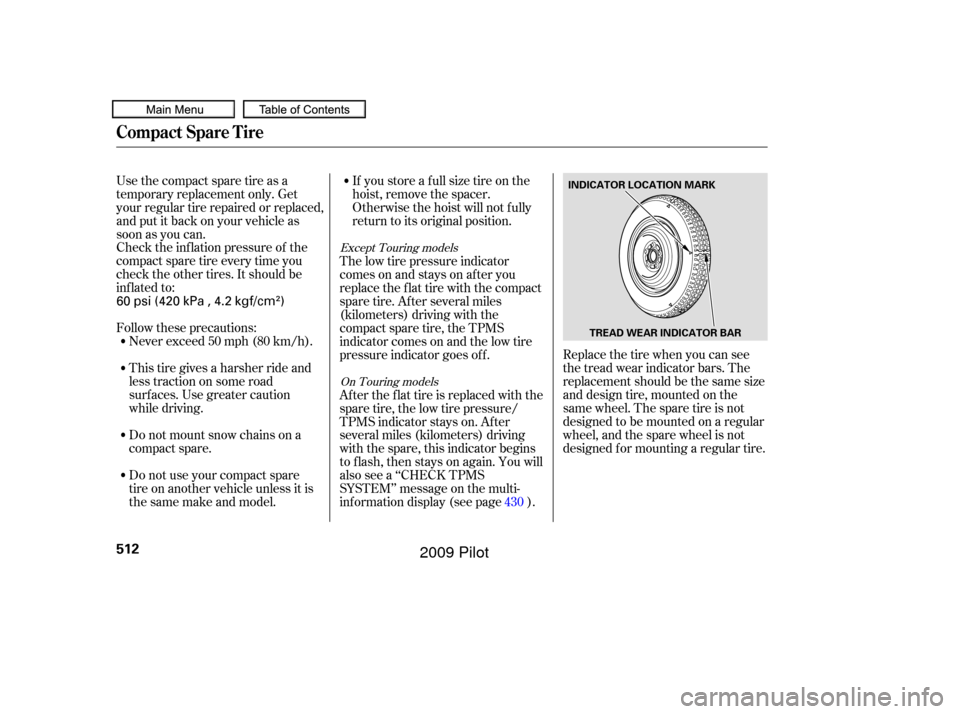Page 508 of 578
TheABSworksbycomparingthe
speed of the wheels. When replacing
tires, use the same size originally
supplied with the vehicle. Tire size
and construction can affect wheel
speed and may cause the system to
activate.
When the tires are rotated, make
sure the air pressures are checked.It is best to replace all f our tires at
thesametime.If thatisnotpossible
or necessary, replace the two f ront
tires or two rear tires as a pair.
Replacing just one tire can seriously
af f ect your vehicle’s handling.
If you ever replace a wheel, make
sure that the wheel’s specif ications
match those of the original wheels.Also be sure you use only TPMS
specif ic wheels. If you do not, the
tire pressure monitoring system will
not work.
Tires
504
�����—�����—�
���y�
�������������y���
�(�/���������y���������y
2009 Pilot
Page 516 of 578

Check the inf lation pressure of the
compact spare tire every time you
check the other tires. It should be
inf lated to:
Follow these precautions:Never exceed 50 mph (80 km/h).
Do not mount snow chains on a
compact spare.
Do not use your compact spare
tire on another vehicle unless it is
thesamemakeandmodel.
Use the compact spare tire as a
temporary replacement only. Get
your regular tire repaired or replaced,
and put it back on your vehicle as
soon as you can.
This tire gives a harsher ride and
less traction on some road
surf aces. Use greater caution
while driving. If you store a f ull size tire on the
hoist, remove the spacer.
Otherwise the hoist will not f ully
return to its original position.
Replace the tire when you can see
the tread wear indicator bars. The
replacement should be the same size
and design tire, mounted on the
same wheel. The spare tire is not
designed to be mounted on a regular
wheel, and the spare wheel is not
designed f or mounting a regular tire.
The low tire pressure indicator
comes on and stays on af ter you
replace the flat tire with the compact
spare tire. Af ter several miles
(kilometers) driving with the
compact spare tire, the TPMS
indicator comes on and the low tire
pressure indicator goes of f .
After the flat tire is replaced with the
spare tire, the low tire pressure/
TPMS indicator stays on. After
several miles (kilometers) driving
with the spare, this indicator begins
to f lash, then stays on again. You will
also see a ‘‘CHECK TPMS
SYSTEM’’ message on the multi-
inf ormation display (see page ).
430Except Touring models
On Touring models
Compact Spare Tire
512
INDICATOR LOCATION MARK
TREAD WEAR INDICATOR BAR
60 psi (420 kPa , 4.2 kgf/cm)
�����—�����—�
���y�
���������
���y���
�(�/���������y�����
���y
2009 Pilot
Page 523 of 578
Slowly turn the extension with the
wheel nut wrench clockwise to
take up the slack of the hoist cable.
Make sure the bracket is seated in
the center hole of the flat tire.
Turn the extension with the wheel
nut wrench clockwise until the f lat
tire rests against the underbody of
the vehicle and you hear the hoist
click.Store the jack and the tools in the
tool box.
Refer to
(see page or ). 426 431
23.
24. 25.
26.
Changing a Flat Tire
Changing a T ire with
TPMS
T aking Care of t he Unexpect ed
519
WHEEL NUT WRENCH
Loose items can fly around the
interiorinacrashandcould
seriously injure the occupants.
Store the wheel, jack, and tools
securely before driving.
Always raise the spare tire hoist, even
if you are not stowing a tire. If the
hoist is lef t down, it will be damaged
during driving and need to be replaced.
�����—�����—�
���y�
�������������y���
�(�/���������y���������y
2009 Pilot
Page 538 of 578

�µ
�µ�µ
�µ
�µ
�Î
�Î
No. Amps.
Circuits Protected
No. Amps. Circuits Protected
No. Amps.
Circuits Protected
6
7
8
9
10
11
12
13
14
15
16
17
18
19
20
21 10 A
7.5 A
7.5 A
7.5 A 10 A
10 A
10 A
7.5 A 15 A
15 A
15 A
20 A
15 A
7.5 A 20 A
VTM-4
Fuel Pump
ACG
VSA
Heated Seat
1
2
3
4
5 7.5 A
15 A
10 A
7.5 A 15 A VBSOL2
STRLD
Not Used
Not Used
Driver’s Power Window
HAC OP
Moonroof
Door Lock
Front Passenger’s Power
Window
Audio Amp
Passenger’s Side Rear
Power Window
Driver’s Side Rear Power
Window
Not Used
ACC
HAC
Day Light
Wiper
22
23
24
25
26
27
28
29
30
31
32
33
34
35
36
37
38 7.5 A
7.5 A
20 A
20 A
20 A
20 A
20 A
30 A
20 A
20 A
10 A
10 A
7.5 A 30 A
Not Used
Auto Light
Auto Light
ODS
Meter
SRS
Right Daytime Running Light
Lef t Daytime Running Light
Small Lights (Interior)
Small Lights (Exterior)
Right Head Light Low
Left Head Light Low
Daytime Running Light Main
Small Lights Main
Not Used
TPMS
Head Light Low Main
: On vehicles with rear entertainment system
Fuse Locations
534
INTERIOR FUSE BOX
�����—�����—�
���y�
�������������y���
�(�/���������y���������y
2009 Pilot
Page 543 of 578
�µ
Thediagramsinthissectiongive
you the dimensions and capacities of
your vehicle and the locations of the
identif ication numbers. It also
includes inf ormation you should
know about your vehicle’s tires and
emissions control systems. ................
Identif ication Numbers . 540
................................
Specif ications .542
DOT Tire Quality Grading ..........................
(U.S. Vehicles) .544
.................................
Tire Labeling .546
Tire Pressure Monitoring System (TPMS) Required Federal ............................
Explanation .548
.......................
Emissions Controls .551
..
Three Way Catalytic Converter . 553
........................
Emissions Testing .554
T echnical Inf ormation
Technical Inf ormation
539
�����—�����—�
���y�
�������������y���
�(�/���������y���������y
2009 Pilot
Page 552 of 578

�µ
Each tire, including the spare (if
provided), should be checked
monthly when cold and inf lated to
the inf lation pressure recommended
by the vehicle manuf acturer on the
vehicle placard or tire inf lation
pressure label.
(If your vehicle has tires of a
dif f erent size than the size indicated
on the vehicle placard or tire
inf lation pressure label, you should
determine the proper tire inf lation
pressure f or those tires.)As an added safety feature, your
vehicle has been equipped with a tire
pressure monitoring system (TPMS)
that illuminates a low tire pressure
telltale
when one or more of your tires is
signif icantly under-inf lated.
Accordingly, when the low tire
pressure telltale illuminates, you
should stop and check your tires as
soon as possible, and inf late them to
the proper pressure.Driving on a signif icantly under
inf lated tire causes the tire to
overheat and can lead to tire failure.
Underinf lation also reduces f uel
efficiency and tire tread life, and may
af f ect the vehicle’s handling and
stopping ability.
Please note that the TPMS is not a
substitute for proper tire
maintenance, and it is the driver’s
responsibility to maintain correct tire
pressure, even if under-inf lation has
not reached the level to trigger
illumination of the TPMS low tire
pressure telltale.
Tire Pressure Monitoring System (TPMS) Required Federal Explanation
548
�����—�����—�
���y�
������
������y���
�(�/���������y���������y
2009 Pilot
Page 553 of 578
�µ
Always check the TPMS malf unction
telltale af ter replacing one or more
tires or wheels on your vehicle to
ensure that the replacement or
alternate tires and wheels allow the
TPMS to continue to f unction
properly.
Your vehicle has also been equipped
with a TPMS malf unction indicator
to indicate when the system is not
operating properly. The TPMS
malf unction indicator is provided by
a separate telltale, which displays the
symbol ‘‘TPMS’’ when illuminated.
TPMS malf unctions may occur f or a
variety of reasons, including the
installation of replacement or
alternate tires or wheels on the
vehicle that prevent the TPMS f rom
f unctioning properly. When the malf unction indicator is
illuminated,
the system may not be able to detect
or signal low tire pressure as
intended.Except Touring models
Tire Pressure Monitoring System (TPMS) Required Federal Explanation
Technical Inf ormation
549
�����—�����—�
���y�
������
��
���y���
�(�/���������y���������y
2009 Pilot
Page 554 of 578

�µ
TPMS malf unctions may occur f or a
variety of reasons, including the
installation of replacement or
alternate tires or wheels on the
vehicle that prevent the TPMS f rom
f unctioning properly.
Always check the TPMS malf unction
telltale af ter replacing one or more
tires or wheels on your vehicle to
ensure that the replacement or
alternate tires and wheels allow the
TPMS to continue to f unction
properly.
When the malf unction indicator is
illuminated, the system may not be
able to detect or signal low tire
pressure as intended. Your vehicle has also been equipped
with a TPMS malf unction indicator
to indicate when the system is not
operating properly. The TPMS
malf unction indicator is combined
with the low tire pressure telltale.
When the system detects a
malf unction, the telltale will f lash f or
approximately one minute and then
remain continuously illuminated.
This sequence will continue upon
subsequent vehicle start-ups as long
as the malfunction exists.On Touring models
Tire Pressure Monitoring System (TPMS) Required Federal Explanation
550
�����—�����—�
���y�
������
��
���y���
�(�/���������y���������y
2009 Pilot